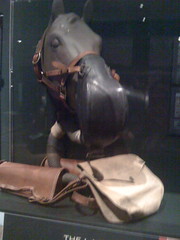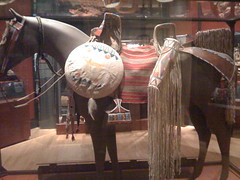Museum of Natural History- Kate Jackson
Museum of Natural History
Horse Exhibit
This exhibit is devoted solely to (you guessed it) the horse. It starts off with the horse’s beginnings, its ancestors and how it evolved into the horse known today. It makes note of the fact that no true wild horses exist today-the American “wild horse,” or mustang, is really just the descendants of other equines shipped over here, mainly by the Spanish. They’re not truly wild, in other words. The closest modern-day equivalent to wild horses is the Przewalski horse, an Asiatic living fossil. The rest of the beginning of the exhibit is mostly statistics and facts, although they do make interesting mention of zebras. Apparently, zebras are territorial (unlike horses), so they can’t share turnout. They’ll fight. Also, zebras are very aggressive. More zoo handlers are injured by zebras than by tigers, and zebra injuries nearly equal that of all other zoo animal-inflicted as a whole.
Before horses were transportation, they were food. Cave paintings feature the horse more than any other animal. These paintings closely resemble the modern-day Przewalski horse. Apparently they were quite tasty. The exhibit traces the gradual use of horses for transportation, from pulling sledges to being ridden and harnessed to wagons/chariots. Unlike most domesticated animals, the horse’s bone structure didn’t change rapidly after domestication, making it hard for archeologists to tell the difference between wild and tame animals. Horses and other herd animals are easy to domesticate, as they naturally establish a pack hierarchy and will submit to authority, as opposed to lone or pair animals that don’t bend to a lower ranking. Horses can be trained to do many things unnatural to them, like carry riders, pull loads, and jump fences. Training mostly takes cues that horses respond to naturally, and applies them to specific ends. Horses don’t instinctively want to jump over things. In the wild, it’s a good way to break a leg. However, the urge to remain with the herd is much stronger. To teach young horses to jump, first we would lay down ground poles, or cavelettis. It’s not a big deal to walk over them for most young animals. Gradually, the bar is raised. To encourage reluctant horses to cross poles and low fences, a “rabbit” is often used-an older or more experienced horse that the young horse can follow. Techniques similar to this are used to teach young horses to lead, or to follow humans when “leashed.” Foals are walked alongside their dams, with a person walking beside them with a lead. The horse will come to accept the person as a surrogate mother to follow, which is why a small and relatively weak person can lead about a much bigger animal.
Horses were used extensively in warfare. They were used in Japan by the samurai, and in Europe by mounted knights. Samurai were expected to be able to accurately fire their bows from horseback at a gallop, and it has evolved into a sport practiced to this day. Knights often had 3 horses at their disposal: destriers (large horses that carried heavy plate armor) coursers (more agile horses for running battles) and rounceys (placid beasts used for travel). Mongols carried off daring raids from the backs of their hardy ponies, and horses figure into the cowboy and indian myths of America. Even in modern times, US Special Forces will use horses for transportation in terrain unsuitable for vehicles. During World War II, horses were often used in support capacities, pulling ambulance wagons and such. They were fitted with their own special gas masks, which (unlike human masks) left the eyes unprotected.
In many cultures, horses were a sign of wealth. They were sometimes revered as holy, but I’m not sure how people reconciled riding their god about. Until fairly recently in human history, riding was the fastest form of transportation, and helped shape expansion. Horses are also terrific athletes, with many sports focussed around them: dressage, polo, cross country, show jumping, racing, polo, trick riding, rodeo events, barrel racing, pole bending, gymkhana events, and reining. The exhibit featured a looping video of famous riding events, including the Triple Crown, the 2000 Olympics, and the Marshall & Sterling finals. I enjoyed the last, as I know and competed against the girl shown in the video- it was taken from the 2007 Marshall & Sterling finals, and I whipped her soundly in points and at the show.
Riding in all its forms is an inherently dangerous sport, for both riders and horses. Sport Illustrated states that being a jockey on flat races is the most dangerous athletic profession. For horses, with their delicate legs, many sports such as jumping and racing are extremely strenuous. Race track injuries are rampant, as evidenced by Barbaro’s broken leg during one of the past Triple Crown races.

Image of a samurai’s saddle. The stirrups are different than those of most modern saddles in the you don’t put your foot through it. It’s a smart design, as the stirrups used today for most saddles are apt to trap your foot if you fall. A horse once flipped over on me, and my leg became tangled in the stirrups. I was dragged around the ring for a good five minutes before the leathers broke. It may not sound long, but it was an eternity for me at the time.

Picture of the gas mask horses were outfitted for during WWII. It was probably motivated less by altruism and more by the fact that a horse going nuts off nerve gas and dying (to leave an unwieldy corpse) would be inconvenient to say the least.

Gear a wealthy Sioux woman would have decked her horse out in. It’s hard to take it seriously, as the way it’s designed would have made it useless for anything other than riding-the girth for the blankets can’t be tightened enough to hold the padding secure, much less save a rider if she attempted to use the ornately beaded stirrups. It’s flashy though.

Heather Jansch driftwood sculpture of a horse. It’s impressive, and life-size. Horses are elegant in form, and make for great art. Much of the gear used for riding is art in for its own sake. Western saddles often feature ornate silver decoration, along with the gear of spanish vaqueros. Bits were designed with elaborate shanks, and the bridle/saddle leather was embossed and worked into beautiful designs. It ties into the discussion of what is art-although these pieces have a clear utility and purpose, great skill undoubtedly went into making them, and they’re beautiful. The photos don’t do justice to the exhibit, but the guards were frowning on photography.

Cave painting, Lascaux Horse, The Granger Collection, New York

Przewalski horse (modern day) [http://library.thinkquest.org/C0114235/geography_PROTECTED_GOBI.htm]
Look familiar?
Comments
Leave a Reply
You must be logged in to post a comment.


